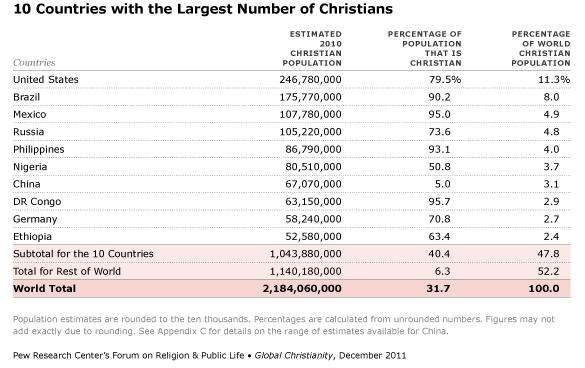Pew Research Center’s Forum on Religion & Public Life

With Christmas fast approaching, the Pew Research Center’s Forum on Religion & Public Life published a new comprehensive demographic report on the size and distribution of the world’s Christian population. The study finds that there are 2.18 billion Christians of all ages in more than 200 countries around the world, representing nearly a third of the estimated 6.9 billion 2010 global population. Christians are so geographically widespread that no single continent or region can indisputably claim to be the center of global Christianity.

In 1910, two-thirds of the world’s Christians lived in Europe (according to historical data from the Center for the Study of Global Christianity at Gordon-Conwell Theological Seminary in Massachusetts). Today, the Pew study finds, only about a quarter of all Christians (26%) live in Europe (26%). A plurality — more than a third (37%) — now reside in the Americas. About one in every four Christians (24%) lives in sub-Saharan Africa and about one-in-eight (13%) is found in Asia and the Pacific.
In the last 100 years, the number of Christians around the world has more than tripled from historical estimates of approximately 600 million in 1910 to more than two billion today. But the world’s overall population has also risen rapidly, from an estimated 1.8 billion in 1910 to 6.9 billion in 2010. As a result, Christians make up about the same portion of the world’s population in 2010 (32%) as they did a century ago (35%).
This apparent stability, however, masks a momentous shift. Although Europe and the Americas still are home to a majority of the world’s Christians (63%), that share is much lower than it was in 1910 (93%). The proportion of Europe’s population that is Christian dropped from 95% in 1910 to 76% in 2010, while the proportion of the overall population in the Americas (North America, Latin America and the Caribbean, combined) that is Christian fell from 96% to 86%. Over the same period, however, Christianity grew enormously in sub-Saharan Africa and significantly in the Asia-Pacific region, where there were relatively few Christians at the beginning of the 20th century. The share of the population that is Christian in sub-Saharan Africa climbed from 9% in 1910 to 63% in 2010, while in the Asia-Pacific region it rose from 3% to 7%.
These are some of the key findings of Global Christianity: A Report on the Size and Distribution of the World’s Christian Population, which provides data on the world’s Christian population by region, country and tradition based on a country-by-country analysis of approximately 2,400 sources, including censuses and nationally representative population surveys. The study is part of the Pew-Templeton Global Religious Futures project, an effort funded by The Pew Charitable Trusts and the John Templeton Foundation to analyze religious change and its impact on societies around the world.
Additional findings include:
• Christians are diverse theologically as well as geographically. About half are Catholic. Protestants, broadly defined, make up 37%. Orthodox Christians comprise 12% of Christians worldwide. Other Christians, such as Mormons and Jehovah’s Witnesses, make up the remaining 1% of the global Christian population.
• Taken as a whole Christians are by far the world’s largest religious group. Muslims, the second-largest group, make up a little less than a quarter of the world’s population according to previous studies by the Pew Forum.
• Almost half (48%) of all Christians live in the 10 countries with the largest number of Christians. Three of the top 10 are in the Americas (the United States, Brazil and Mexico). Two are in Europe (Russia and Germany); two are in the Asia-Pacific region (the Philippines and China); and three are in sub-Saharan Africa (Nigeria, Democratic Republic of the Congo and Ethiopia), reflecting Christianity’s global reach.
• Although Christianity began in the Middle East-North Africa, that region today has both the lowest concentration of Christians (about 4%) and the smallest number of Christians (about 13 million) of any major geographic region.
• Although Christians comprise just under a third of the world’s people, they form a majority of the population in 158 countries and territories, about two-thirds of all the countries and territories in the world.
• Nigeria now has more than twice as many Protestants (broadly defined to include Anglicans and independent churches) as Germany, the birthplace of the Protestant Reformation.
• About 90% of Christians live in countries where Christians are in the majority; only about 10% of Christians worldwide live as minorities.
Disclaimer: Articles featured on Oregon Report are the creation, responsibility and opinion of the authoring individual or organization which is featured at the top of every article.

